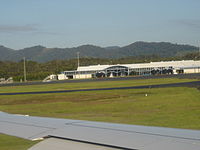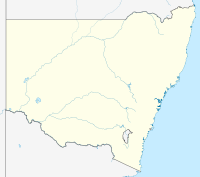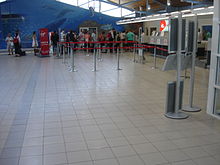- Coffs Harbour Airport
-
Coffs Harbour Airport 
View of the airport terminal from the runway IATA: CFS – ICAO: YCFS Location of airport in New South Wales Summary Airport type Public Operator Coffs Harbour City Council Location Coffs Harbour Elevation AMSL 18 ft / 5 m Coordinates 30°19′14″S 153°06′59″E / 30.32056°S 153.11639°E Runways Direction Length Surface ft m 03/21 6,824 2,080 Asphalt 10/28 2,785 849 Asphalt Coffs Harbour Airport: (IATA: CFS, ICAO: YCFS) is the only airport located on and serving the regional centre of Coffs Harbour, Australia. The airport is located near Boambee, south of Coffs Harbour. Coffs Harbour Regional Airport is one of the largest and busiest regional airports in New South Wales, handling numerous types of aircraft. The airport is currently serviced by three carriers, Qantas, Virgin Australia and Brindabella Airlines, and has the capacity to handle aircraft up to the size of a 240-seat Boeing 767. Coffs Harbour airport is located right at the doorstep of the Pacific Highway which links all of Coffs Harbour and surrounding areas to the airport.
The airport currently handles over 26,000 aircraft movements a year, 5,000 of which are for passenger aircraft. The terminal handled 321,678 passengers in the 2009 financial year, a large increase of passengers compared to 2005.[1]
Contents
Airport facilities and services
Facilities
Coffs Harbour airport features commercial and general aviation facilities, charter facilities, helicopter services, aircraft maintenance services, a Qantas lounge, Coffee Lounge and a 24-hour undercover security car park next to the terminal. Six car rental companies are located at the airport.[2]
Open air paid parking is provided for over 200 cars.[2]
Meteorological services
The Coffs Harbour Meteorological Office was established on the 13th of November, 1940. Initially only 2 forecasters and 1 Observer was offered at the Coffs Harbour Aerodrome, the slot was not filled until August 4, 1942, when a USAAF Observer Meteorological Office (MO) was established. On February 1, 1943, The USAAF withdrew and a RAAF Observer and Interpreter was assigned to the Office, The office was back in use 2 days later, using a converted oil shed as the Meteorological Office (MO). In May 1943 the MO was moved to the previous operations building.[3]
On 26 September 1967, Observations moved to a newly purpose built $70,000 (AUD) Meteorological Office. With the increasing complexity of technology in the Observation network, it was decided to permanently appoint an Electronics Officer at Coffs Harbour to maintain electronic equipment throughout the area. The Observation office was extended to include a Regional Workshop and an upgraded radar.
On 24 December 1996, with the anticipated closing of Williamtown Meteorological Office, an Upper Air program commenced at Coffs Harbour to serve as a replacement. A radiosonde was included with the weather balloon flights which transmitted temperature, humidity and pressure data as it ascended through the atmosphere. The program ceased late September 1998 when it was decided to leave Williamtown open.[3]
To this day the Coffs Harbour Meteorological office is operational and has recently gone through even more upgrades to better the facility and area. The Coffs Harbour Meteorological Office takes care of all of the Coffs Harbour region and is part of the Australian Bureau of Meteorology[3]
History
The airport was established by the Council in 1928. It was requisitioned by the Royal Australian Air Force during World War II for the purposes of an airbase for anti submarine patrols. No. 71 Squadron and 'C' Flight No. 73 Squadron operated from the base from 1943 until being disbanded in late 1944. No. 12 Operational Base Unit maintained and serviced the airfield during its operation. A number of bunkers associated with the RAAF's occupation of the airfield exist near the airfield.[citation needed]
In the early 1990s, Council gained full ownership of the airport, and it became clear that expansion would be necessary to meet the needs of the future, and to establish Coffs Harbour as a major regional center. This aim is set out in Council's Business Plan for the airport. In 1994 planning began to upgrade the airport terminal and runway at the price of $8 million. Stage one of the project was the widening of the main runway, and construction work started in May 1999.[4]
Terminal expansion
At the end of 1999 work started on the $4 million terminal expansion, intended to overcome serious overcrowding at peak times and to meet growing demand for at least the next 10 years. The new expanded terminal became operational in November 2000, and opened its doors with a large celebration and air show.
All of this work was completed without cost to state or federal governments, and without cost to the taxpayer. The airport is fully self-sufficient. Only those using the airport are paying for the facilities. Money for the upgrades is being repaid over the next 14 years through operating profits.[4]
Airlines and destinations
Airlines Destinations Brindabella Airlines Brisbane [5] Qantas operated by QantasLink Sydney Virgin Australia Melbourne, Sydney Statistics
The airport currently handles over 26,000 aircraft movements per annum, 5,000 of which are for passenger aircraft.[1]
Annual passenger statistics for Coffs Harbour Airport[1] Year Total Passengers 2004-2005 260,000 2006-2007 300,000 2008-2009 321,678 2009-2010 323,687 Operations
Busiest Domestic Routes out of Coffs Harbour Airport(Year Ending September 2010) [6] Rank Airport Passengers % Change Carriers 1  Sydney Airport
Sydney Airport302,000  2.1
2.1Virgin Australia, QantasLink Incidents and accidents
On May 15, 2003, an Ambulance Service of New South Wales Beechcraft B200C King Air aircraft had to make an emergency landing at Coffs Harbour Airport after it hit the sea, a reef or the Harbour's Breakwall near the Coffs Harbour boat harbour during an instrument approach in heavy rain and poor visibility. One of the main landing gear legs was torn off; there were no injuries.[7] The aircraft was subsequently scrapped.
External links
- Coffs Harbour Airport
- Coffs Airport Security Carpark
- Coffs Coast Aviation Centre
- Coffs Harbour and District Aero Club
- Information on General Aviation and Commercial Training at Coffs Harbour
- Airservices Australia Aerodome Chart
References
- ^ a b c Coffs Airport, Website, Accessed September 2007
- ^ a b Coffs Airport Facilities, Accessed September 2007
- ^ a b c Bureau of Meteorology, Coffs Harbour > History
- ^ a b Coffs Council-Airport History, Accessed September 2007
- ^ Brindabella Airlines - Schedule
- ^ Domestic airline activity
- ^ Final ATSB report into the Coffs Harbour CFIT accident, Accessed September 2007
Albury • Armidale • Ballina • Bankstown • Bathurst • Belmont • Bourke • Broken Hill • Camden • Cessnock • Cobar • Coffs Harbour • Cooma • Coonabarabran • Coonamble • Corowa • Deniliquin • Dubbo • Evans Head • Goulburn • Grafton • Griffith • Hay • Illawarra • Inverell • Lightning Ridge • Lismore • Lord Howe Island • Merimbula • Moree • Moruya • Mudgee • Narrabri • Narrandera • Newcastle • Nyngan • Orange • Palm Beach • Parkes • Port Macquarie • Tamworth • Taree • Temora • Wagga Wagga • Walgett • West Wyalong • Warnervale • YoungThis lists all airports classed as regional in New South Wales including those without scheduled passenger services. Categories:- Airports in New South Wales
- Airports established in 1928
Wikimedia Foundation. 2010.




